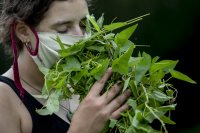
ES students seek to reconnect Androscoggin, residents
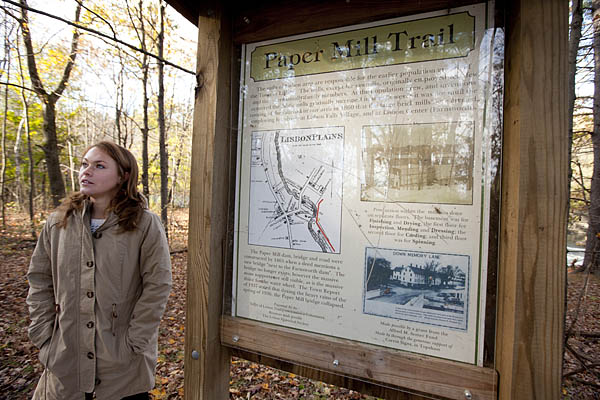
Georgia Doucette ’12 during a visit to a finished portion of the municipal trail system in Lisbon, Maine.
“The Androscoggin tells such a story,” says Leigh Michael ’12. “It caused this town to blossom into a metropolis. But today the river is just not the focal point of Lewiston-Auburn’s economy.”
Michael, of Andover, N.J., is one of 28 environmental studies students who spent the fall contributing to the next chapter of that story: the chapter in which residents and visitors reconnect with the river through recreation, enlivening the local economy in the process.
The three student groups who developed signage plans for Androscoggin River trails in Lewiston, Lisbon and Livermore Falls present their work at 7 p.m. Thursday, Dec. 15, in the Muskie Archives, 70 Campus Ave.
Once so polluted that it influenced U.S. Sen. Edmund Muskie ’36 to create the U.S. Clean Water Act, the Androscoggin was for decades something to avoid, not paddle on or picnic beside. But 40 years after the passage of Muskie’s Clean Water Act, a much cleaner Androscoggin is ready to support a variety of recreational activities — and add still another attraction to Maine tourism, the state’s largest industry.
The trick is to rebrand the river, to convince the public that it’s a place they want to be. Working with governments and nonprofits in several riverside communities, the Bates students in an environmental studies (ES) capstone course undertook a variety of projects to advance that rebranding effort.
The river is evolving from an industrial to a recreational economic resource, says Tom Wenzel, Dana Professor of Chemistry, who taught the upper-level seminar with ES professor Jane Costlow. “Those transitions from industry to recreation, from dirty to clean, are causing communities on the river to look at it in a new way,” he says.
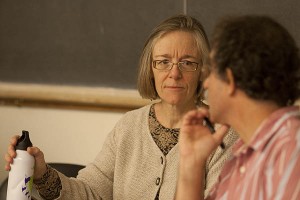
Jane Costlow, professor of environmental studies, and Dana Professor of Chemistry Thomas Wenzel taught the ES capstone seminar.
Titled “Community-Engaged Research in Environmental Studies,” Wenzel and Costlow’s course integrates and provides a societal context for what ES majors learn. Its theme varies, but what’s constant is a community emphasis that asks students to consider a spectrum of human-environmental relationships.
Working with such community partners as the Androscoggin Land Trust, Wenzel and Costlow developed eight projects for their students. Michael’s group collaborated with L/A Arts, the local cultural agency, to create river-related arts curriculum materials for middle and high school students.
Another group fashioned a business plan for a canoe and kayak rental service in Lewiston. Delving into the occult legalese of the regulatory realm, two teams researched the representation of recreational interests in the licensing agreements for five Androscoggin hydropower dams.
All the students “had to meet with the community partners,” Costlow says. “They had to use their academic skills to put together a reasonable proposal” — deliverables, a timeline, a description of methodology, a working bibliography and proposals for handing off the projects in a turnkey condition for others to continue.
On the trail
Bradley Gee ’12 of San Francisco and his group developed an interpretative signage plan for a riverside trail to be built next year in the river town of Lisbon. (Other students undertook similar projects for Lewiston and Livermore Falls.)
The trail will complete a system crossing Lisbon from Lewiston to Topsham. “We focused on incorporating history and ecology, and on making it a really usable trail that provides a sense of place,” says Gee. The trail will pass by a salmon spawning area, former Native American settlements and sites of the mills that once drove Lisbon’s economy.
As both an amenity and a potential source of tourism and visitor revenues, “this trail system is really important to the community,” says Scott Benson, Lisbon’s director of economic and community development. Among Benson’s requests of the students was a sign concept that would encourage visitors, as they leave the trail, to press on to downtown Lisbon and perhaps spend some money.
The students’ research and consultation efforts brought them to Benson’s office, the town’s Trails Commission and public works department, and the local historical society (where students got to see, among other historical evidence, fabric samples from the storied Worumbo mill).
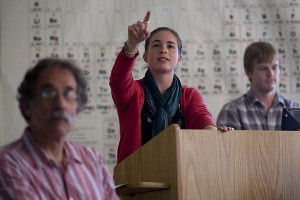
As professor Tom Wenzel, at left, and Bradley Gee ’12 look on, Gwynneth Johnson ’12 makes a point about the Lisbon trail signage plan.
The project gave Gee a new perspective on the relationship among industry, community and the environment. “As an ES major, you tend to focus on the environmental problem,” he says. “This project may fit the ES major, but it is not necessarily an ecological problem. We’re dealing with community revival, and that’s new territory for us.”
For the Lisbon signage, the deliverables were a mass of site-specific, ready-to-use research, and mockups demonstrating approaches to signage design. “Their job was to provide us with a consistent look and feel, and then instruct us in how to tell our story,” Benson says. “And they’ve done that.”
In fact, in these times of straitened municipal budgets, the students’ contribution is something Lisbon likely couldn’t have gotten any other way, he says. “It’s just such a huge gift.” And one that keeps on giving, as the project has left the town better-prepared to attract funding to finish the trail.
Do you speak ES?
Bates ES majors choose a concentration such as ecology, environmental economics or environment in the literary and visual arts. The project teams in the capstone course, by design, represent a mix of these concentrations, emphasizing the interdisciplinarity central to environmental studies.
“Some ES majors talk more in chemistry terms, interested in toxins and those kinds of environmental hazards,” says Gee. “There are people who are more involved in the rebranding aspect of it.” And others focused on historical or aesthetic concerns.
“Because we’ve all taken the same core ES classes, we’re all speaking the same language,” he says, “but we all do seem to bring something different to the table.”
This confluence of perspectives played out in other ways. Working with the community partners afforded valuable experience in shaping presentations to suit the audience. On the one hand, “in academic settings, it was acceptable to present more abstract ideas and larger questions,” says another member of the Lisbon team, Georgia Doucette ’12 of Cumberland, Maine.
On the other, in meetings with the Trails Commission or Benson, the presentations were more to the point. “It’s more important to deliver and receive information efficiently,” Doucette says.
Lessons learned
“It really has been a lesson in how you see a project through,” says Gee. “We had our expectations from Jane and Tom, but also expectations from Scott, and we had a responsibility to all of them. Then we have our expectations within our group. And balancing those things is a project in itself.”
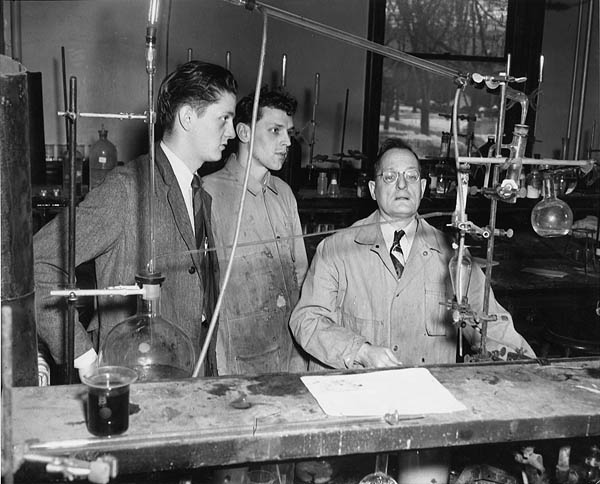
Bates chemistry professor Walter Lawrance, the Androscoggin “river master” for more than three decades, works with students in this 1949 photo. Photo courtesy of the Edmund S. Muskie Archives and Special Collections Library.
The course has extended a Bates-Androscoggin relationship dating back at least to the 1940s, when chemistry professor Walter Lawrance became the state-appointed “river master.” From 1943 to 1977, Lawrance involved Bates students in his pioneering efforts to measure, analyze and curtail the pollution from paper mills and other sources.
This year, geology professor Beverly Johnson and a group of her students completed the transfer of Lawrance’s river data, held in the college’s Edmund S. Muskie Archives, into an electronic format much more accessible and useful to researchers.
Meanwhile, economist Lynne Lewis, who made news nationally for her research into the connection between dam removal on the Kennebec River and nearby real estate values, has undertaken a similar project with the Androscoggin.
Beyond Bates, regional efforts are under way to understand the still-shifting relationship between river and inhabitants. As Gee says, Lisbon — like other former mill towns on other rivers all over the post-industrializing world — “is here because the mills were here.” And once the mills are gone, how do residents define their town, and by extension themselves?
Such a situation engenders the desire “to begin gathering stories, telling your story, thinking reflectively about what has made a particular place,” Costlow says. “Who are we now? We’re a different town — and what are the stories that we’re going to tell about who we are?”


